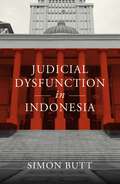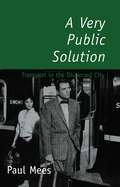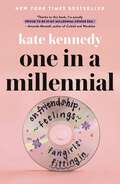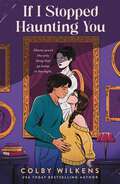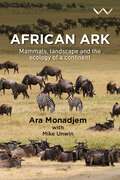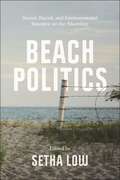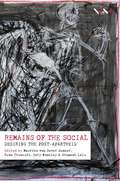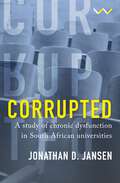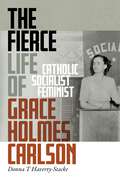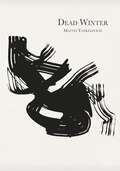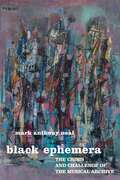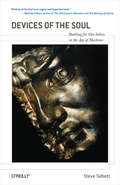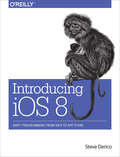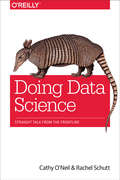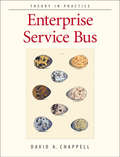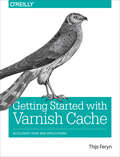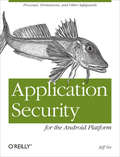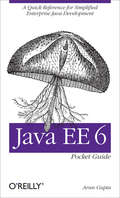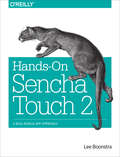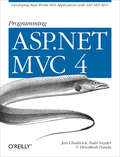- Table View
- List View
Party Thieves: The Real Story of the 2010 Election
by Barrie CassidyBarrie Cassidy picked a hell of an election to cover: changes of leaders on both sides of politics, Australia's first female Prime Minister, a hung parliament and a country not knowing who its Prime Minister was for nearly three weeks.But in the beginning were the Party Thieves, Malcolm Turnbull and Kevin Rudd. Turnbull's manic desire to get his own way in the party, and because he simply stopped listening, led to his demise. Rudd stole the party through his authoritarian approach to government and a cabinet that felt alienated from the job of governing.In both cases, the members of their respective parties came at the Party Thieves to reclaim what was rightfully theirs, and set the stage for the ascension of Tony Abbott and Julia Gillard.And all that before we even get to the 2010 election campaign.The Party Thieves is more than just a campaign diary of the extraordinary 2010 election and its aftermath; it is a rip-roaring, incisive analysis of a tumultuous nine months in politics that even surprised veteran journalists such as Cassidy. This is a must read for anyone interested in Australian politics of any persuasion.
Islam and the Question of Reform (Islamic Studies Series)
by Benjamin MacQueen Kylie Baxter Rebecca BarlowReform, by definition, is not a complete break with tradition, but a determination by scholars, activists, politicians and critical thinkers to re-claim the tenets of their faith. Muslim communities have historically displayed a tendency to preserve the status quo. By contrast, the individuals and movements in Islam and the Question of Reform are determined; often at great personal risk; to push aside existing political and social elites and the historically accepted interpretations of Islam and its place in society. The perspectives examined in this volume avoid superficial or apologetic examinations of Islam's political and social role. Instead, they meticulously scrutinise the religion's public role, often questioning the validity of dogmas that have acted as tools of empowerment for existing elites for centuries. Islamic Studies Series - Volume 1
Private Bill: In Love and War
by Barrie CassidyBarrie Cassidy's dad Bill survived more than four years as a prisoner of war in World War II. He first saw conflict on Crete in May 1941, during the only large-scale parachute invasion in wartime history. Just four days later, Bill was wounded and eventually captured.Twice he tried to escape his internment—with horrific consequences. He suffered greatly but found courageous support from his fellow prisoners.His new wife Myra and his large family thought he was dead until news of his capture finally reached them.Back home, Myra too was a prisoner of sorts, with her own secrets. Then, fifty years after the war, unhealed wounds unexpectedly opened for Bill and Myra, testing them once again.Private Bill is a classic heart-warming story—as told by their son—of how a loving couple prevailed over the adversities of war to live an extraordinarily ordinary, happy life.
Judicial Dysfunction in Indonesia
by Simon ButtIndonesia's judicial system has long been described as dysfunctional. Many of its problems developed out of decades of authoritarian rule, which began in the last few years of the reign of Indonesia's first president, Soekarno. By the time President Soeharto's regime fell in 1998, the judiciary had virtually collapsed. Judicial dependence on government, inefficiency and corruption were commonly seen as the main indicators of poor performance, resulting in very low levels of public trust in the courts. To address these problems, reformists focused on improving judicial independence. Yet while independence is a basic prerequisite for adequate judicial performance, much depends on how this independence is exercised. Judicial Dysfunction in Indonesia demonstrates that Indonesian courts have tended to act without accountability and offers detailed analysis of highly controversial decisions by Indonesian courts, many of which have been of major political significance, both domestically and internationally. It sets out in concrete terms, for the first time, how bribes are negotiated and paid to judges and demonstrates that judges have issued poor decisions and engaged in corruption and other misconduct, largely without fear of retribution. Further, it explores unsafe convictions and public pressure as a threat to judicial independence. Judicial Dysfunction in Indonesia shines a sorely needed empirical light on the Indonesian judicial system, and is an essential resource for readers, scholars and students of Indonesian law and society.
Very Public Solution
by Paul MeesWhy is public transport so poor in Australian cities? Why can't it be more like the fast, convenient systems in Europe? Unlike Europeans, most urban Australians live on far-flung suburban blocks rather than in high-density apartments. Most urban travel is to widespread suburban locations rather than to the city centre. It is often argued that fast, efficient public transport is impossible in our 'dispersed' cities. In A Very Public Solution, Paul Mees compares Melbourne's public transport system with the highly successful system in Toronto; a 'dispersed' city very like Melbourne with its suburban sprawl, and sheds new light on a century-old debate. This debate is particularly important now, as 'economic rationalists' move to privatise public transport in Australian cities. We can have European-style public transport, Mees argues, if our different forms of public transport stop competing with each other and start competing with the car. A Very Public Solution is the first serious work on public transport planning ever published in Australia. It is essential reading for everyone concerned with urban sustainability and our growing traffic problems.
Mal Goes to War: A Novel
by Edward AshtonThe humans are fighting again. Go figure.As a free A.I., Mal finds the war between the modded and augmented Federals and the puritanical Humanists about as interesting as a battle between rival anthills. He’s not above scouting the battlefield for salvage, though, and when the Humanists abruptly cut off access to infospace he finds himself trapped in the body of a cyborg mercenary, and responsible for the safety of the modded girl she died protecting.A dark comedy wrapped in a techno thriller’s skin, Mal Goes to War provides a satirical take on war, artificial intelligence, and what it really means to be human.
One in a Millennial: On Friendship, Feelings, Fangirls, and Fitting In
by Kate KennedyINSTANT NEW YORK TIMES BESTSELLERNATIONAL BESTSELLERFrom pop culture podcaster and a voice of a generation, Kate Kennedy, a celebration of the millennial zeitgeistOne In a Millennial is an exploration of pop culture, nostalgia, the millennial zeitgeist, and the life lessons learned (for better and for worse) from coming of age as a member of a much-maligned generation.Kate is a pop culture commentator and host of the popular millennial-focused podcast Be There in Five. Part-funny, part-serious, Kate navigates the complicated nature of celebrating and criticizing the culture that shaped her as a woman, while arguing that great depths can come from surface-level interests.With her trademark style and vulnerability, One In a Millennial is sharp, hilarious, and heartwarming all at once. She tackles AOL Instant Messenger, purity culture, American Girl Dolls, going out tops, Spice Girl feminism, her feelings about millennial motherhood, and more. Kate’s laugh-out-loud asides and keen observations will have you nodding your head and maybe even tearing up.
If I Stopped Haunting You
by Colby Wilkens"If you're in the mood for a steamy enemies-to-lovers romance but also a chilling haunted-house horror, GET YOU A BOOK THAT CAN DO BOTH! I blazed through this book in one sitting because I just couldn't wait to find out what would happen next!" - Alicia Thompson, USA Today bestselling author of With Love, from Cold WorldAn enemies to lovers romance where two feuding writers end up on a writers retreat together at a haunted castle in Scotland...It's been months since horror author Penelope Skinner threw a book at Neil Storm. But he was so infuriating, with his sparkling green eyes and his bestselling horror novels that claimed to break Native stereotypes. And now she’s a publishing pariah and hasn’t been able to write a word since. So when her friend invites her on a too-good-to-be-true writers retreat in a supposedly haunted Scottish castle, she seizes the opportunity. Of course, some things really are too good to be true.Neil wants nothing less than to be trapped in a castle with the frustratingly adorable woman who threw a book at him. She drew blood! Worse still, she unleashed a serious case of self-doubt! Neil is terrified to write another bestselling “book without a soul,” as Pen called it. All Neil wants is to find inspiration, while completely avoiding her.But as the retreat begins, Pen and Neil are stunned to find themselves trapped in a real-life ghost story. Even more horrifying, they’re stuck together and a truly shocking (extremely hot) almost-kiss has left them rethinking their feelings, and… maybe they shouldn’t have been enemies at all? But if they can’t stop the ghosts pursuing them, they may never have the chance to find out.Full of spooky chills and even more sexy thrills, If I Stopped Haunting You by Colby Wilkens is the funny, fast-paced romp romance readers have been waiting for!"I didn't realize I needed a romance book married to cozy horror but now I'm wondering where this particular mashup has been all my life. Can't wait to read the next!" - Jessica Clare, New York Times bestselling author
African Ark: Mammals, landscape and the ecology of a continent
by Dr. Ara MonadjemThe story of how Africa’s mammals have helped shape the continent’s landscapes over time to support an amazing diversity of lifeAfrica is home to an amazing array of animals, including the world’s most diverse assortment of large mammals. These include the world’s largest terrestrial mammal, the African elephant, which still roams great swathes of the continent alongside a host of other well-known large mammals with hooves such as hippopotamuses, giraffes, rhinoceroses, and zebras. African Ark: Mammals, Landscape and the Ecology of a Continent tells the story of where these mammals have come from and how they have interacted to create the richly varied landscape that makes up Africa as we know it today. It gives an equal airing to small mammals, such as rodents and bats, which are often overlooked by both naturalists and zoologists in favor of their larger cousins. African Ark not only describes the diversity of African mammals and the habitats in which they live; it also explains the processes by which species and population groups are formed and how these fluctuate over time. A book on mammals would not be complete without attention placed on the impact of megafauna on the environment and the important roles they play in shaping the landscape. In this way, mammals such as elephants and rhinoceros support countless plant communities and the habitats of many smaller animals. The book brings in a human perspective as well as a conservation angle in its assessment of the interaction of African mammals with the people who live alongside them. African Ark is at once scientifically rigorous and accessible for the layperson and student alike, while drawing on the contributions of numerous zoologists, ecologists and conservationists dedicated to the understanding of Africa and its wildlife.
Beach Politics: Social, Racial, and Environmental Injustice on the Shoreline
by Setha LowExplores how elites restrict access to public beaches around the globeBeaches are a beloved form of public space. Yet there has been an alarming global trend of restricting access to public sections of beaches to ensure that waterfront property owners can enjoy the shoreline exclusively or develop the land for commercial use.Beach Politics examines how over the past forty years, privatization of public space has accelerated with the help of both local governments and national corporations. On a local level, this can entail a group of wealthy neighbors purposely blocking off public beach access in their neighborhood: hiring security guards, building fences, or putting up “No Trespassing” signs to turn away members of the public who have every right to be there. On a state or national level, it can manifest as gated communities owned by private corporations sectioning off huge swaths of land, limiting access, or governments promoting private, rather than public, development along the shoreline. Whenever disputes about land use arise, the powers that be often side with private interests and the wealthy over those with fewer resources and, frequently, people of color. With the continuing threat of climate change, decisions about how and where to harden or protect the shoreline often limits public use.Focused on beaches, access to public space, and social justice, this book brings together powerful contributions illustrating how these issues are inextricably bound with socioeconomic status, racial segregation, and climate justice. Together they highlight how, through illegal actions and exclusionary legislation, the beach can be transformed from “a strip of nature” into a palimpsest of greed, racism, ecological disregard, and socioeconomic discrimination.
Remains of the Social: Desiring the post-apartheid
by Ross TruscottAn interdisciplinary volume of essays that engages with what ‘the social’ might mean after apartheid. Remains of the Social is an interdisciplinary volume of essays that engages with what 'the social' might mean after apartheid; a condition referred to as 'the post-apartheid social'. The volume grapples with apartheid as a global phenomenon that extends beyond the borders of South Africa between 1948 and 1994 and foregrounds the tension between the weight of lived experience that was and is apartheid, the structures that condition that experience and a desire for a 'post-apartheid social' (think unity through difference). Collectively, the contributors argue for a recognition of the 'the post-apartheid' as a condition that names the labour of coming to terms with the ordering principles that apartheid both set in place and foreclosed. The volume seeks to provide a sense of the terrain on which 'the post-apartheid' - as a desire for a difference that is not apartheid's difference - unfolds, falters and is worked through.
Corrupted: A study of chronic dysfunction in South African universities
by Jonathan D JansenIn South African higher education, the images of dysfunction are everywhere. Student protests. Violence. Police presence. Rubber or real bullets. Class disruptions. Burning tyres. Damaged buildings. Injury and sometimes death. Reports of wholesale corruption. Year after year, often in the same set of universities; the problem of routine instability seems insoluble.The financial, academic and reputational costs of ongoing dysfunction are high, especially for those universities caught-up in the never-ending struggle to overcome apartheid legacies. Any number of explanations have been ventured, including a lack of resources, shortage of capacity, rural location, corrupt officials, and endemic conflict. Corrupted takes a deeper look at dysfunction in an attempt to unravel the root causes in a sample of South African universities.At the heart of the problem lies the vexed issue of resources or, more pertinently, the relationship between resources and power: who gets what, and why? Whatever else it aspires to be—commonly, a place of teaching, learning, research and public duty—a university in an impoverished community is also a rich concentration of resources around which corrupt staff, students and those outside of campus all vie for access.Taking a political economic approach, Jonathan Jansen describes the daily struggle for institutional resources and offers accessible, sensible insights. He argues that the problem won’t be solved through investments in ‘capacity building’ alone because the combination of institutional capacity and institutional integrity contributes to serial instability in universities. Rather, durable solutions would include the depoliticisation of university councils and appointments of academics with integrity and capacity to manage and lead these fragile institutions.This groundbreaking and long overdue study will offer a promising way forward for universities to better serve their communities and the country more broadly.
The Fierce Life of Grace Holmes Carlson: Catholic, Socialist, Feminist
by Donna T. Haverty-StackeShares the story of the revolutionary Marxist and Catholic Grace Holmes Carlson and her life-long dedication to challenging social and economic inequalityOn December 8, 1941, Grace Holmes Carlson, the only female defendant among eighteen Trotskyists convicted under the Smith Act, was sentenced to sixteen months in federal prison for advocating the violent overthrow of the government. After serving a year in Alderson prison, Carlson returned to her work as an organizer for the Socialist Workers Party (SWP) and ran for vice president of the United States under its banner in 1948. Then, in 1952, she abruptly left the SWP and returned to the Catholic Church. With the support of the Sisters of St. Joseph, who had educated her as a child, Carlson began a new life as a professor of psychology at St. Mary’s Junior College in Minneapolis where she advocated for social justice, now as a Catholic Marxist.The Fierce Life of Grace Holmes Carlson: Catholic, Socialist, Feminist is a historical biography that examines the story of this complicated woman in the context of her times with a specific focus on her experiences as a member of the working class, as a Catholic, and as a woman. Her story illuminates the workings of class identity within the context of various influences over the course of a lifespan. It contributes to recent historical scholarship exploring the importance of faith in workers’ lives and politics. And it uncovers both the possibilities and limitations for working-class and revolutionary Marxist women in the period between the first and second wave feminist movements. The long arc of Carlson’s life (1906–1992) ultimately reveals significant continuities in her political consciousness that transcended the shifts in her particular partisan commitments, most notably her life-long dedication to challenging the root causes of social and economic inequality. In that struggle, Carlson ultimately proved herself to be a truly fierce woman.
Dead Winter
by Matvei YankelevichThese twenty-seven poems of Dead Winter continue the poet’s ongoing “From a Winter Notebook” cycle which plays on traditional winter themes of stasis, ruin, aging, lost love, belatedness, dormancy, and decline. Aggressively personal, by turns ironic and sentimental, mixing colloquial and archly artificial diction, rife with quotations and reference to a wide variety of lyric traditions, these poems stage a polyphonic and ambivalent internal dialog that vacillates between the often-contradictory desires of social justice and personal freedom. Straining to resist impending erosion in the political tide, the singular voice seeks to hold these contradictions up to the light and to contemplate their prismatic refractions without resolution. Caught between complicity and antagonism, between the impending obsolescence of inherited poetic traditions and a desire to commune with the contemporary, the voice churns on—miming winter’s monotony—to carve out a space for melancholic complaint and anxious meditation on the end-times endeavor of the lyric mode itself. Through representations of desire and melancholy in a technologically invasive era, these poems also ask about the effect of technological and political shifts on the bounds of the personal, and of the way a techno-oriented sociality impinges on interpersonal relationships, the interior dialogs of the self, and the writing of poetry.
Black Ephemera: The Crisis and Challenge of the Musical Archive
by Mark Anthony NealPROSE Award- Music and Performing Arts Category WinnerA framework for understanding the deep archive of Black performance in the digital eraIn an era of Big Data and algorithms, our easy access to the archive of contemporary and historical Blackness is unprecedented. That iterations of Black visual art, such as Bert Williams’s 1916 silent film short “A Natural Born Gambler” or the performances of Josephine Baker from the 1920s, are merely a quick YouTube search away has transformed how scholars teach and research Black performance.While Black Ephemera celebrates this new access, it also questions the crisis and the challenge of the Black musical archive in a moment when Black American culture has become a global export. Using music and sound as its primary texts, Black Ephemera argues that the cultural DNA of Black America has become obscured in the transformation from analog to digital. Through a cross-reading of the relationship between the digital era and culture produced in the pre-digital era, Neal argues that Black music has itself been reduced to ephemera, at best, and at worst to the background sounds of the continued exploitation and commodification of Black culture. The crisis and challenges of Black archives are not simply questions of knowledge, but of how knowledge moves and manifests itself within Blackness that is obscure, ephemeral, fugitive, precarious, fluid, and increasingly digital. Black Ephemera is a reminder that for every great leap forward there is a necessary return to the archive. Through this work, Neal offers a new framework for thinking about Black culture in the digital world.
Devices of the Soul: Battling for Our Selves in an Age of Machines
by Steve Talbott"Self-forgetfulness is the reigning temptation of the technological era. This is why we so readily give our assent to the absurd proposition that a computer can add two plus two, despite the obvious fact that it can do nothing of the sort--not if we have in mind anything remotely resembling what we do when we add numbers. In the computer's case, the mechanics of addition involve no motivation, no consciousness of the task, no mobilization of the will, no metabolic activity, no imagination. And its performance brings neither the satisfaction of accomplishment nor the strengthening of practical skills and cognitive capacities."In this insightful book, author Steve Talbott, software programmer and technical writer turned researcher and editor for The Nature Institute, challenges us to step back and take an objective look at the technology driving our lives. At a time when 65 percent of American consumers spend more time with their PCs than they do with their significant others, according to a recent study, Talbott illustrates that we're forgetting one important thing--our Selves, the human spirit from which technology stems.Whether we're surrendering intimate details to yet another database, eschewing our physical communities for online social networks, or calculating our net worth, we freely give our power over to technology until, he says, "we arrive at a computer's-eye view of the entire world of industry, commerce, and society at large...an ever more closely woven web of programmed logic."Digital technology certainly makes us more efficient. But when efficiency is the only goal, we have no way to know whether we're going in the right or wrong direction. Businesses replace guiding vision with a spreadsheet's bottom line. Schoolteachers are replaced by the computer's dataflow. Indigenous peoples give up traditional skills for the dazzle and ease of new gadgets. Even the Pentagon's zeal to replace "boots on the ground" with technology has led to the mess in Iraq. And on it goes.The ultimate danger is that, in our willingness to adapt ourselves to technology, "we will descend to the level of the computational devices we have engineered--not merely imagining ever new and more sophisticated automatons, but reducing ourselves to automatons."To transform our situation, we need to see it in a new and unaccustomed light, and that's what Talbott provides by examining the deceiving virtues of technology--how we're killing education, socializing our machines, and mechanizing our society.Once you take this eye-opening journey, you will think more clearly about how you consume technology and how you allow it to consume you."Nothing is as rare or sorely needed in our tech-enchanted culture right now as intelligent criticism of technology, and Steve Talbott is exactly the critic we've been waiting for: trenchant, sophisticated, and completely original. Devices of the Soul is an urgent and important book."--Michael Pollan, author of The Omnivore's Dilemma: A Natural History of Four Meals and The Botany of Desire: A Plant's Eye View of the World"Steve Talbott is a rare voice of clarity, humanity, and passion in a world enthralled by machines and calculation. His new book, Devices of the Soul, lays out a frightening and at the same time inspiring analysis of what computers and computer-like thinking are doing to us, our children, and the future of our planet. Talbott is no Luddite. He fully understands and appreciates the stunning power of technology for both good and evil. His cool and precise skewering of the fuzzy thinking and mindless enthusiasm of the technology true believers is tempered by his modesty, the elegance of his writing, and his abiding love for the world of nature and our capacity for communion with it. "--Edward Miller, Former editor, Harvard Education Letter"Those who care about the healthy and wholesome lives of children can gain much from Steve Talbott's wisdom. He examines the need to help children spe
The New Community Rules: Marketing on the Social Web
by Tamar WeinbergBlogs, networking sites, and other examples of the social web provide businesses with a largely untapped marketing channel for products and services. But how do you take advantage of them? With The New Community Rules, you'll understand how social web technologies work, and learn the most practical and effective ways to reach people who frequent these sites. Written by an expert in social media and viral marketing, this book cuts through the hype and jargon to give you intelligent advice and strategies for positioning your business on the social web, with case studies that show how other companies have used this approach. The New Community Rules will help you:Explore blogging and microblogging, and find out how to use applications such as Twitter to create brand awarenessLearn the art of conversation marketing, and how social media thrives on honesty and transparencyManage and enhance your online reputation through the social webTap into the increasingly influential video and podcasting marketDiscover which tactics work -- and which don't -- by learning about what other marketers have triedMany consumers today use the Web as a voice. The New Community Rules demonstrates how you can join the conversation, contribute to the community, and bring people to your product or service.
Introducing iOS 8: Swift Programming from Idea to App Store
by Steve DericoLearn to make iOS apps even if you have absolutely no programming experience. This hands-on book takes you from idea to App Store, using real-world examples—such as driving a car or eating at a restaurant—to teach programming and app development. You’ll learn concepts through clear, concise, jargon-free language.This book focuses on Apple’s new programming language, Swift. Each lesson is divided into two parts: the lecture portion explains the terms and concepts through examples, and the exercise portion helps you apply these concepts while building real-world apps, like a tip calculator. Learn how to think differently—and see the world from a whole new perspective.Learn the basic building blocks of programmingDive into the Swift programming languageMake apps for iPhone and iPadUse GPS in your app to find a user’s locationTake or select photos with your appIntegrate your app with Facebook and TwitterSubmit your app to the App StoreManage and market your app on the App Store
Doing Data Science: Straight Talk from the Frontline
by Cathy O'Neil Rachel SchuttNow that people are aware that data can make the difference in an election or a business model, data science as an occupation is gaining ground. But how can you get started working in a wide-ranging, interdisciplinary field that’s so clouded in hype? This insightful book, based on Columbia University’s Introduction to Data Science class, tells you what you need to know.In many of these chapter-long lectures, data scientists from companies such as Google, Microsoft, and eBay share new algorithms, methods, and models by presenting case studies and the code they use. If you’re familiar with linear algebra, probability, and statistics, and have programming experience, this book is an ideal introduction to data science.Topics include:Statistical inference, exploratory data analysis, and the data science processAlgorithmsSpam filters, Naive Bayes, and data wranglingLogistic regressionFinancial modelingRecommendation engines and causalityData visualizationSocial networks and data journalismData engineering, MapReduce, Pregel, and HadoopDoing Data Science is collaboration between course instructor Rachel Schutt, Senior VP of Data Science at News Corp, and data science consultant Cathy O’Neil, a senior data scientist at Johnson Research Labs, who attended and blogged about the course.
Enterprise Service Bus: Theory in Practice
by David A ChappellLarge IT organizations increasingly face the challenge of integrating various web services, applications, and other technologies into a single network. The solution to finding a meaningful large-scale architecture that is capable of spanning a global enterprise appears to have been met in ESB, or Enterprise Service Bus. Rather than conform to the hub-and-spoke architecture of traditional enterprise application integration products, ESB provides a highly distributed approach to integration, with unique capabilities that allow individual departments or business units to build out their integration projects in incremental, digestible chunks, maintaining their own local control and autonomy, while still being able to connect together each integration project into a larger, more global integration fabric, or grid.Enterprise Service Bus offers a thorough introduction and overview for systems architects, system integrators, technical project leads, and CTO/CIO level managers who need to understand, assess, and evaluate this new approach. Written by Dave Chappell, one of the best known and authoritative voices in the field of enterprise middleware and standards-based integration, the book drills down into the technical details of the major components of ESB, showing how it can utilize an event-driven SOA to bring a variety of enterprise applications and services built on J2EE, .NET, C/C++, and other legacy environments into the reach of the everyday IT professional.With Enterprise Service Bus, readers become well versed in the problems faced by IT organizations today, gaining an understanding of how current technology deficiencies impact business issues. Through the study of real-world use cases and integration patterns drawn from several industries using ESB--including Telcos, financial services, retail, B2B exchanges, energy, manufacturing, and more--the book clearly and coherently outlines the benefits of moving toward this integration strategy. The book also compares ESB to other integration architectures, contrasting their inherent strengths and limitations.If you are charged with understanding, assessing, or implementing an integration architecture, Enterprise Service Bus will provide the straightforward information you need to draw your conclusions about this important disruptive technology.
Getting Started with Varnish Cache: Accelerate Your Web Applications
by Thijs FerynHow long does it take for your website to load? Web performance is just as critical for small and medium-sized websites as it is for massive websites that receive tons of hits. Before you pour money and time into rewriting your code or replacing your infrastructure, first consider a reverse-caching proxy server like Varnish. With this practical book, you’ll learn how Varnish can give your website or API an immediate performance boost.Varnish mimicks the behavior of your webserver, caches its output in memory, and serves the result directly to clients without having to access your webserver. If you’re a web developer familiar with HTTP, this book helps you master Varnish basics, so you can get up and running in no time. You’ll learn how to use the Varnish Configuration Language and HTTP best practices to achieve faster performance and a higher hit rate.Understand how Varnish helps you gain optimum web performanceUse HTTP to improve the cache-ability of your websites, web applications, and APIsProperly invalidate your cache when the origin data changesOptimize access to your backend serversAvoid common mistakes when using Varnish in the wildUse logging and debugging tools to examine the behavior of Varnish
Application Security for the Android Platform: Processes, Permissions, and Other Safeguards (Oreilly And Associate Ser.)
by Jeff SixWith the Android platform fast becoming a target of malicious hackers, application security is crucial. This concise book provides the knowledge you need to design and implement robust, rugged, and secure apps for any Android device. You’ll learn how to identify and manage the risks inherent in your design, and work to minimize a hacker’s opportunity to compromise your app and steal user data.How is the Android platform structured to handle security? What services and tools are available to help you protect data? Up until now, no single resource has provided this vital information. With this guide, you’ll learn how to address real threats to your app, whether or not you have previous experience with security issues.Examine Android’s architecture and security model, and how it isolates the filesystem and databaseLearn how to use Android permissions and restricted system APIsExplore Android component types, and learn how to secure communications in a multi-tier appUse cryptographic tools to protect data stored on an Android deviceSecure the data transmitted from the device to other parties, including the servers that interact with your app
Java EE 6 Pocket Guide: A Quick Reference for Simplified Enterprise Java Development
by Arun GuptaThis handy guide provides an overview of Java Enterprise Edition 6’s main technologies and includes extensive, easy-to-understand code samples that demonstrate the platform’s many improvements. You’ll quickly understand how Java EE 6 simplifies the process of developing and deploying web and enterprise applications.Explore what’s new in Java EE 6, including Contexts and Dependency Injection and the Java API for RESTful Web ServicesDiscover how Java EE 6 features relate to design patterns in web and enterprise applicationsGet the specifications for making your application Java EE compliantLearn about revisions to Enterprise JavaBeans, JavaServer Faces, and other componentsFind out how Java EE 6 profiles change the platform’s “one size fits all” approachGet started with Java EE 6 development and deployment, using NetBeans IDE and GlassFish
Hands-On Sencha Touch 2: A Real-World App Approach
by Lee BoonstraGet hands-on experience building speedy mobile web apps with Sencha Touch 2.3, the user interface JavaScript framework built specifically for the mobile Web. With this book, you’ll learn how to build a complete touch application, called Find a Cab, that has the look and feel of a native app on Android, iOS, Windows, and BlackBerry devices.In the process, you’ll work with Sencha’s model-view-controller (MVC) components for form handling, styling, integration with outside data, and other elements. The Sencha Touch learning curve can be steep, but if you’re familiar with JavaScript, HTML5, CSS3, and JSON, this guide will get you up to speed through real-world examples.Learn the fundamentals, including the class and layout systemsUse the Sencha MVC architecture to structure your codeImplement data models and stores, and create an event controllerMake remote connections by implementing server proxiesSave data offline by implementing client proxiesWork with view components such as maps, lists, and floating panelsImplement and handle forms, and construct a custom themeCreate production and native build packages
Programming ASP.NET MVC 4: Developing Real-World Web Applications with ASP.NET MVC
by Hrusikesh Panda Jess Chadwick Todd SnyderGet up and running with ASP.NET MVC 4, and learn how to build modern server-side web applications. This guide helps you understand how the framework performs, and shows you how to use various features to solve many real-world development scenarios you’re likely to face. In the process, you’ll learn how to work with HTML, JavaScript, the Entity Framework, and other web technologies.You’ll start by learning core concepts such as the Model-View-Controller architectural pattern, and then work your way toward advanced topics. The authors demonstrate ASP.NET MVC 4 best practices and techniques by building a sample online auction site ("EBuy") throughout the book.Learn the similarities between ASP.NET MVC 4 and Web FormsUse Entity Framework to create and maintain an application databaseCreate rich web applications, using jQuery for client-side developmentIncorporate AJAX techniques into your web applicationsLearn how to create and expose ASP.NET Web API servicesDeliver a rich and consistent experience for mobile devicesApply techniques for error handling, automated testing, and build automationUse various options to deploy your ASP.NET MVC 4 application



